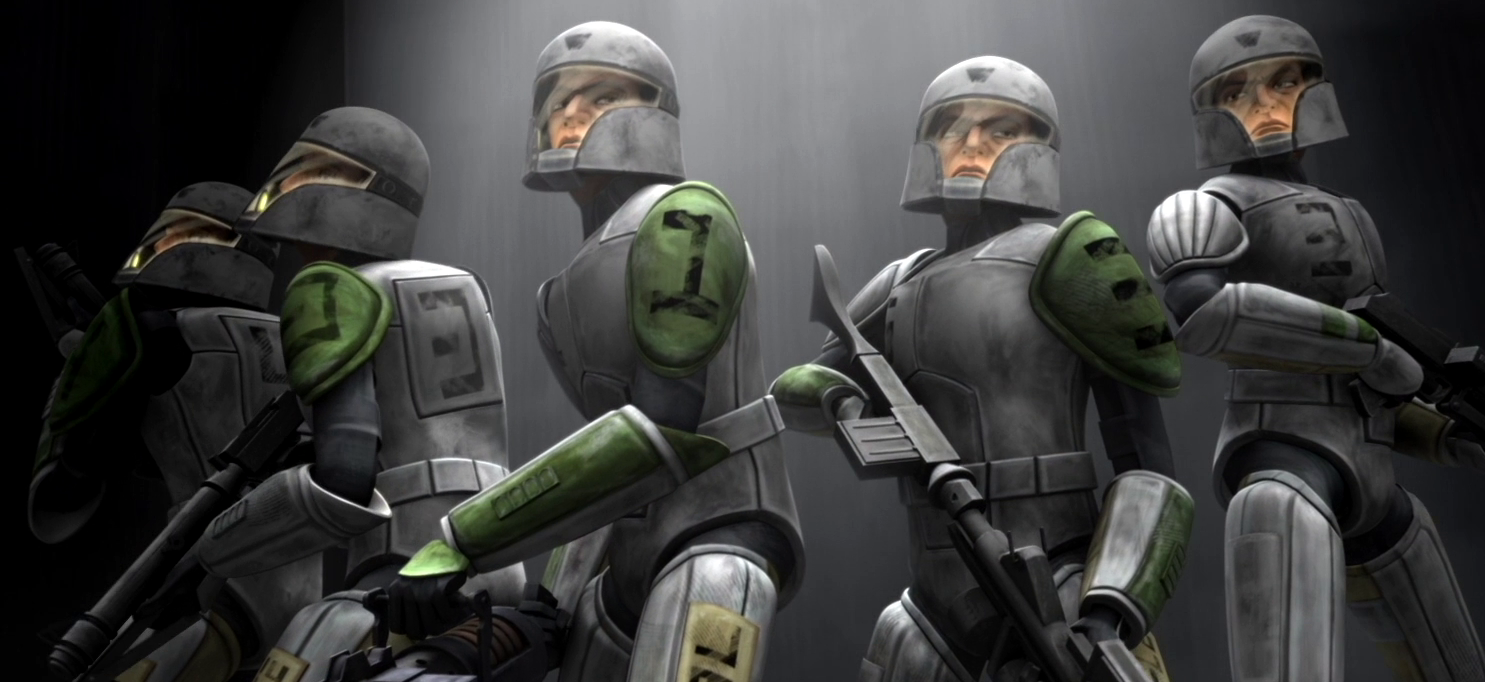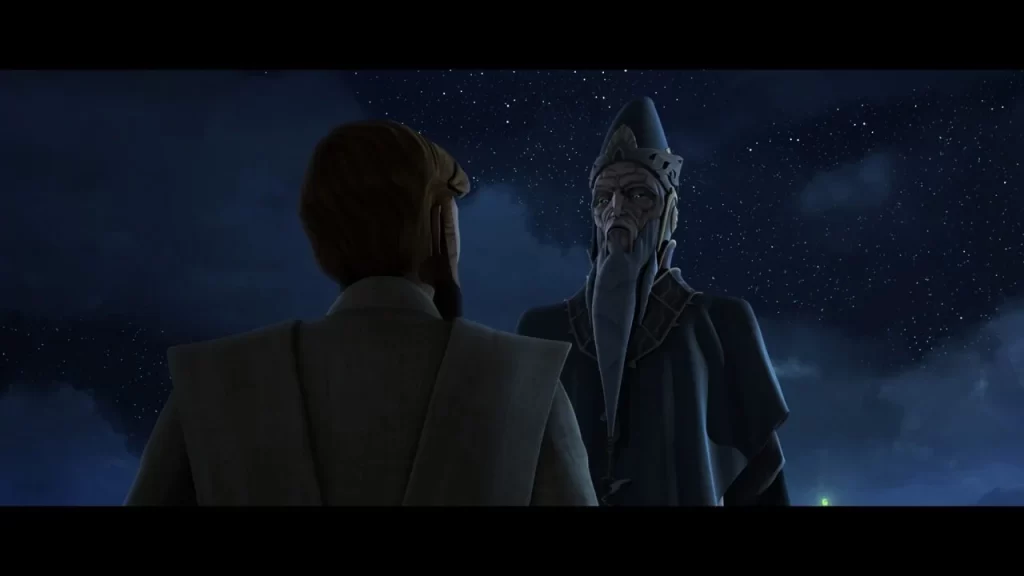Season 3 of Star Wars: The Clone Wars is a turning point in the series, offering some of the most intricate storytelling, compelling character growth, and rich world-building. In this Clone Wars Season 3 breakdown, we’ll explore the key episodes, themes, and character arcs that make this season a fan favorite.
Clone Wars Season 3 Breakdown
Clone Cadets Arc (E1-2):
Episodes focusing on the clones and their role in the galaxy always tend to be my favorites, and the Clone Cadets arc is no exception. The first episode, Clone Cadets, follows Domino Squad during their training on Kamino. They struggle to work together, and the story leans into a familiar “after-school special” trope about learning the value of teamwork. However, it’s executed so well that the ending chokes you up.

Image Attribution: Images sourced from StarWars.com are used under the principles of fair use for purposes of criticism and review. Copyright belongs to Lucasfilm Ltd. and Disney.The second episode, ARC Troopers, raises the stakes as General Grievous and Asajj Ventress launch an attack on Kamino. The clones must defend their home planet, while Anakin and Obi-Wan rush to Tipoca City to help. The scale of this battle is breathtaking, and the emotional weight of the clones fighting to protect their birthplace makes this one of the best episodes in the series.
Supply Lines (E3):
This episode splits its focus between Jedi Master Ima-Gun Di, who is trapped on Ryloth, and Bail Organa’s efforts to secure aid for the besieged Twi’leks. Jar Jar Binks accompanies Bail on this mission, offering some comedic moments that can be interpreted as either clownish or surprisingly clever, depending on your perspective. Despite mixed reviews, this episode does a good job of showcasing the political complexities of the war.
Sphere of Influence (E4):
It amazes me how much Ahsoka Tano has grown as a character. When she was introduced in the Clone Wars movie, I thought she might be annoying or a distraction from Anakin and Obi-Wan’s story. However, Sphere of Influence proves just how far she’s come. In this episode, Ahsoka and Senator Chuchi investigate the Trade Federation after Chairman Papanoida’s daughters are kidnapped. Ahsoka’s ability to carry a storyline on her own shows her growth into one of the series’ most compelling characters.
Mandalore Season 3 Arc (5-6):
Mandalore is one of the most fascinating settings in The Clone Wars. The people of Mandalore are neither fully good nor evil, and they don’t align neatly with the Republic or the Separatists. In the first half of this arc (Corruption), Padmé investigates a mysterious illness at a school, uncovering evidence of the black market.
The second episode (The Academy) shifts focus to Ahsoka, who mentors young cadets and helps them expose a conspiracy. Duchess Satine plays a major role in both episodes, adding depth to her character while proving that Star Wars is no longer a boys’ club.
Assassin (7):
This is one of the best episodes of the series. In Assassin, Ahsoka receives visions of Aurra Sing attempting to assassinate Padmé Amidala. Unlike Anakin, whose premonitions in Revenge of the Sith lead to fear and poor decisions, Ahsoka handles her visions with poise and maturity. The tension in this episode is palpable, proving once again that the female leads in The Clone Wars are just as captivating as their male counterparts.
Evil Plans (8):

Image Attribution: Images sourced from StarWars.com are used under the principles of fair use for purposes of criticism and review. Copyright belongs to Lucasfilm Ltd. and Disney.As with most C-3PO and R2-D2 episodes, Evil Plans leans into a “Rosencrantz and Guildenstern Are Dead” trope. (For the record, I love Rosencrantz and Guildenstern are Dead, so I love this trope!) While the larger action involves Padmé preparing for a Senate reception, the more entertaining story happens in the background with the droids. Cad Bane’s kidnapping of R2 and C-3PO adds a layer of tension to this otherwise lighthearted episode.
The Out of Order Episodes (9-11):
These episodes caused considerable confusion when I first watched them because they don’t line up chronologically. However, if you place them after Season 1’s Hostage Crisis, they make much more sense and even enhance the series’ overall narrative.
- In Hunt for Ziro, Obi-Wan and Quinlan Vos track the escaped Ziro the Hutt, only to find him caught in a web of Hutt family drama.
- In Heroes on Both Sides, Padmé visits her old mentor, Mina Bonteri, a Separatist who advocates for peace. This episode paints the Separatists in a more sympathetic light, challenging the show’s typical good-versus-evil dichotomy.
- Finally, Pursuit of Peace focuses on Padmé and Senator Organa as they oppose funding for additional clone troopers. The political tension and the stakes for these characters are gripping.
The Nightsisters Arc (Episodes 12-14)
Again, Season 3 is one of my favorite seasons. Even the weaker arcs were exciting and still managed to have some character development.
In the Nightsisters arc, the Sith decide to get rid of Asajj Ventress. They don’t succeed, setting off a chain of events that ripple throughout the rest of the series. We see the creation of a new Force-sensitive killer from the same race as Darth Maul.
The Nightsisters are fascinating and deserve their own stories (I’d love to see a comic on them). Their use of magic—as opposed to the Force—adds a unique layer to the Star Wars universe. This arc is easily one of the best in the series.

Image Attribution: Images sourced from StarWars.com are used under the principles of fair use for purposes of criticism and review. Copyright belongs to Lucasfilm Ltd. and Disney.The Mortis Arc (Episodes 15-17)
Usually, a great arc is followed by a one-off or a lighter arc. Not here.
In the Mortis arc, we learn more about the Force, both the light and the dark. We get to see how powerful Anakin is and how corrupting the dark side can be. This arc is another standout and one of the most memorable in the series.
The Citadel Arc (Episodes 18-20)
And yet, a third magnificent arc in a row. This arc delivers plenty of action while introducing us to pre-Imperial Tarkin.

Image Attribution: Images sourced from StarWars.com are used under the principles of fair use for purposes of criticism and review. Copyright belongs to Lucasfilm Ltd. and Disney.Tarkin is a true believer in the military and its use for control. His scenes with Anakin show them agreeing on how to conduct the war. These conversations aren’t inherently evil or dark, but they certainly aren’t the Jedi way.
The Most Dangerous Game Arc (Episodes 21-22)
In this arc, Ahsoka is captured and hunted—hence the nickname I’ve given this arc. We also get to see Chewbacca.
While this arc is entertaining and engaging, it feels like Clone Wars Lite compared to the arcs that precede it.
Themes in The Clone Wars Season 3
- Teamwork and Identity: The Clone Cadets arc highlights the individuality and humanity of the clones, reinforcing the season’s focus on teamwork and shared purpose.
- Political Complexity: Episodes like “Supply Lines” and “Heroes on Both Sides” delve into the ethical ambiguities of war, highlighting the political and moral dilemmas faced by the Republic and the Separatists.
- Ahsoka’s Growth: From Sphere of Influence to Assassin and beyond, Ahsoka’s journey from Padawan to leader is a central focus of the season. Her development into a strong, confident character continues to resonate with fans.
- The Force and Destiny: The Mortis arc offers a deep exploration of the Force, its duality, and Anakin’s destiny as the Chosen One. This theme underscores the overarching narrative of Star Wars.
Why Season 3 Stands Out
Season 3 is a masterclass in blending action, character development, and political intrigue. It’s a season of emotional depth and thrilling battles, from the clones’ fight on Kamino to the dark magic of the Nightsisters and the philosophical musings of the Mortis arc.
The season’s ability to balance large-scale battles, smaller character-driven stories, and complex morality sets it apart. Whether you’re drawn to the clones’ humanity, Ahsoka’s growth, or the exploration of the Force, Season 3 has something for everyone.
What Did You Think of The Clone Wars Season 3?
Season 3 of Star Wars: The Clone Wars offers some of the series’ most iconic moments, from heart-pounding battles to thought-provoking themes. But what makes it truly special is how it expands the Star Wars universe through the humanity of the clones, the strength of its female leads, and the moral complexities of war.
Now it’s your turn! What were your favorite episodes or arcs from Season 3? Did the Mandalore arc or the Mortis trilogy stand out for you? How do you feel about Ahsoka’s character development?
Share your thoughts in the comments below! If you enjoyed this breakdown, don’t forget to share it with fellow Star Wars fans. Let’s keep the conversation going—after all, the galaxy is always better when explored together.
Also, check out these other Reviews of The Clone Wars from us:
About The Author
Discover more from NolaNerdCouple.com
Subscribe to get the latest posts sent to your email.
